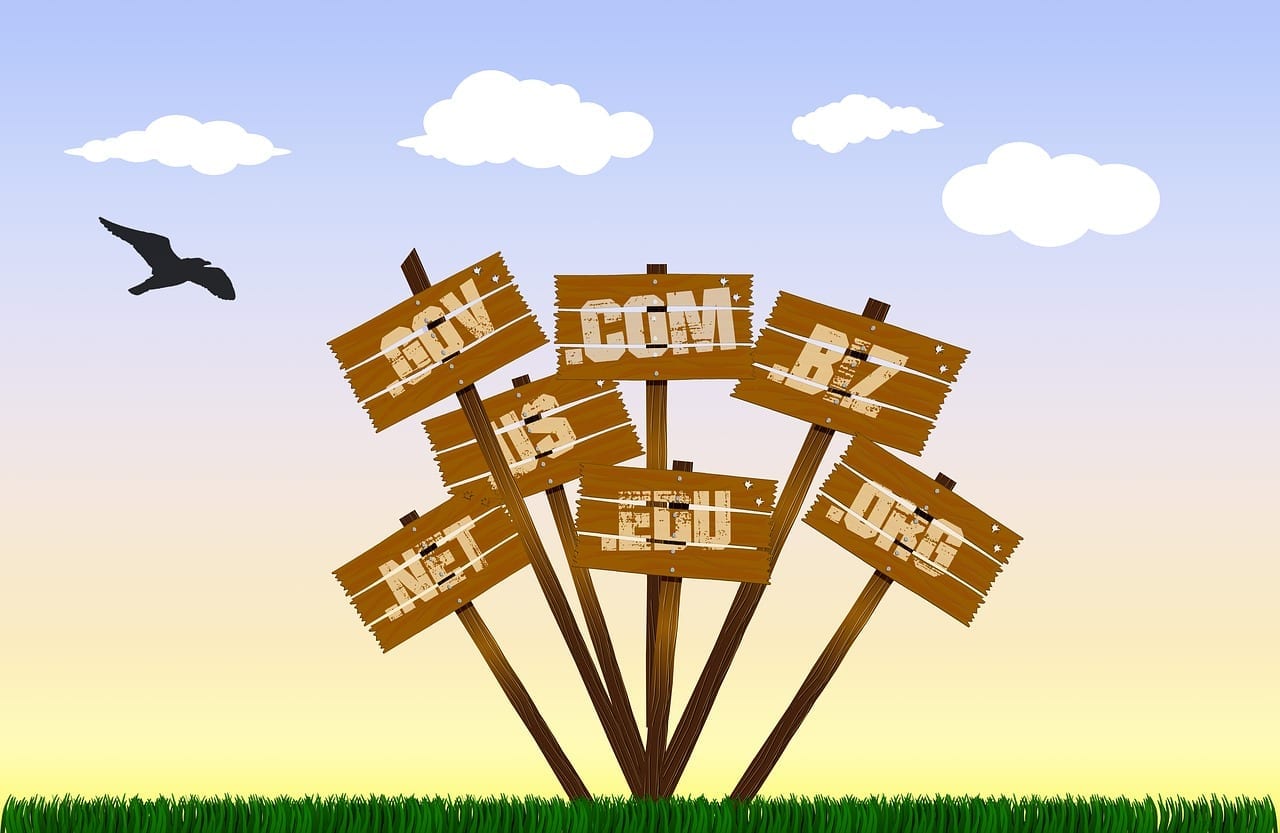I’ve worked with and built websites since the late 90’s so sometimes I take the knowledge I have for granted but every now and then a client will ask a question that will catch me off guard.
Asking a client recently about their domain name for their website that we were quoting on their blank expression told me everything I needed to know. They didn’t know what a domain name is, never mind be able to give me their registrants log in details.
It made me realise that, even some 25 years after the world wide web was invented there’s still a lack of understanding with the general public about the technical aspects of how it all works. We’re all becoming familiar with websites – most people now use some website at least once a day (even if it’s Facebook) but we do it without really understanding how they work.
In this article I plan to explain what a domain name is and why they’re important to the running of your website and the subsequent marketing of your business. If it gets complicated, feel free to leave a comment below and i’ll expand on anything that’s not clear.
A short history lesson on the world wide web
In order to understand what a domain name is and why they’re required we need to first look at how the world wide web (www) was invented and the basic structure that was created to support it.
The first thing to understand is the difference between the INTERNET and the WORLD WIDE WEB. Before the creation of the WWW in 1990, the internet was already in existence and connecting a growing number of computers around the world. But connecting computers together brought problems as there was no overriding language used between them and often users had to learn commands just to work with the remote computers they were linked to.
Tim Berners-Lee, at the time a software engineer at CERN, put forward a plan. He created three elements that together form the world wide web:
- HTML or Hypertext Markup Language – the language of the web
- URI or Uniform Resource Identifier – a way to identify the server or physical resource needed for the web
- HTTP or Hypertext Transfer Protocol – a way to link to resources across the internet.
Where domain names are concerned, we’re interested in the URI. You may have heard of a URL (otherwise known as a Uniform Resource Locator) which is a type of URI and the version that is widely used for websites.
A typical example of a URL could be like our website address : https://www.lobsterdigitalmarketing.co.uk/contact-us/
The domain name is part of the URL – in the example above it’s the lobsterdigitalmarketing.co.uk part. So why is it important? Well, without the domain name we would have to refer to the URI using the sequence of numbers that identify all computers – you’ve probably heard of IP addresses – a sequence of numbers that uniquely identify a computer, printer or other device on a network.
So instead of https://www.lobsterdigitalmarketing.co.uk you might have https://123.456.678.987 which, I think you’ll agree, is quite a mouthful and not of much use to anyone other than another computer.
The domain name allows us to have a readable address for the location of the resources we want to display – i.e. the home page of a website. Imagine if we had to tell people to go to https://192.154.392.23/ every time we wanted to direct them to our website!
How a domain name displays your website
So we now understand why we need a domain name but how does it work in practice.
You have to imagine the internet as a network of computers connected to a single server. If you’ve worked in a large business you’ll understand the concept of a single (or bunch) of servers somewhere in the building with all the employees computers linked to it. Essentially, you have an analogy for the wider internet – it’s a lot of servers connected to a lot of computers via your broadband connection instead of network cables in an office.
Your website is just a bunch of files – like Word documents – that sit on a server somewhere in the world. That server will probably “host” a number of websites all of which are stored inside their own folder on that server.
The server where your website files are stored will understand that if a visitor wants to look at your website it must take them to the correct folder and display the appropriate file (usually something like index.php but could be anything really). The server handles all of this for us.
The clever part is how your browser knows that when you type www.yourdomain.com which server to go to to display the site.
This is all handled by the domain name registrant.
Can you imagine what would happen if anyone could use any domain name for their website? It would be chaos – anyone would be able to create any site with any domain and you would end up with no control and any website could appear for any domain. So, when Berners-Lee invented the world wide web he set up the World Wide Web Consortium (W3C) to manage domain names across the net, keeping a central control over all domains so that the same domain name can’t be used on more than one live site at any time.
When a user opens their browser and types www.yourwebsite.com, the first thing that happens is the browser will interrogate the Domain Name System – a central database of domain names and their associated IP addresses where the website files reside. Think of this as the same as entering the postcode of an address you want to travel to on your satnav and the route being presented to you on the screen. The DNS provides the route for your browser to travel to find your website.
When you reach the correct server that hosts your website, the server then takes over and passes you to the correct folder containing your files.
You don’t own your domain name
This often surprises people but you really only rent your domain name – you never actually own it. That’s because of the way that W3C has to work to keep control over domains.
If you’ve purchased a domain you’ll know that you buy it for a number of years (usually one or two but it can be more). You’re essentially renting the use of that domain for a limited period and if you don’t renew it, you can find that your domain is sold on to someone else for them to use.
To buy a domain, you can’t just go to W3C and buy it from them. You have to buy domains via the appointed domain name registry for the type of domain you want. For example, if you want a .co.uk (or anything ending in .uk) these are all handled by Nominet – the appointed registry for all U.K. domain names. Dot COM (.com) domains are all controlled by Verisign and there are many others around the world usually appointed by the government of each country to manage the relevant country domains.
If you’ve purchased a domain name you’re probably thinking that you’ve never heard of Nominet or Verisign. You’re more likely to have purchased your domain via a company like Fasthosts, GoDaddy or someone like that.
This is because the registries don’t want to be involved in the day-to-day transactions of selling and supporting domain names for consumers so they pass that role on to other commercial organisations, selling domain registration at a wholesale price.
Your domain name can be separate to your website hosting
What you need to understand about your domain name and your website hosting is that they can be separate. Indeed, your website hosting (the server were your website is physically stored), your domain name AND your email can all be on completely separate servers and with completely separate companies.
Why is this important to know? Because business owners I speak to often assume that their website, email address and domain name are all in one place and if you’ve used a web designer (like me) to build your website you may also assume that they have everything in one place – but that’s probably not the case.
For example, our website and email are completely separate from our domain name. To make things slightly more complicated, here at Lobster we use Google Apps (essentially Gmail on steroids) for our email. So we have our domain names with one company, our website is hosted with another (on a U.K. based server that is backed up every day) and our email is provided by Google.
To make things a little more complicated, we also use a Firewall to protect our website from hacking but that’s a subject for another blog post.
You need to understand how your domain, hosting and email are set up because should anything happen to either the company hosting the site (we’ve seen a number of hosting companies cease trading over the years) you need to be able to get to your domain name quickly to change the settings. If nothing else, make sure you know exactly where your domain name is and how you get to it if you need to.
What should you do as a business owner?
My recommendation is, find out from your web designer exactly where your domain name is managed (i.e. Fasthosts, GoDaddy or a service like this) and get hold of the necessary username and passwords to access the account. If they can’t give you that because they have a reseller agreement with that company then ask them if they can move your domain out of their control panel into your own control – after all, what would happen if your web designer went out of business?
My web designer has gone bust, how can I get access to my domain name?
We’ve seen this happen many times over the 13 years we’ve been trading. Businesses have their website created and hosted with a web designer only to find they’ve gone out of business and the website has disappeared.
Thankfully, it’s not as big a problem as you might think. Refer back to my earlier point about Nominet, Verisign etc. These organisations have procedures in place for just this eventuality and with a bit of proof you can have your domain name transferred into your own control for just a few £’s in most cases. Certainly, we’ve always found that Nominet is especially helpful with this which is one of the reasons I will always recommend a .uk domain for our clients first.
I think i’ve covered everything in this article but as always, if you have any questions about your domain that isn’t covered here feel free to comment below and i’ll answer as soon as I can.





